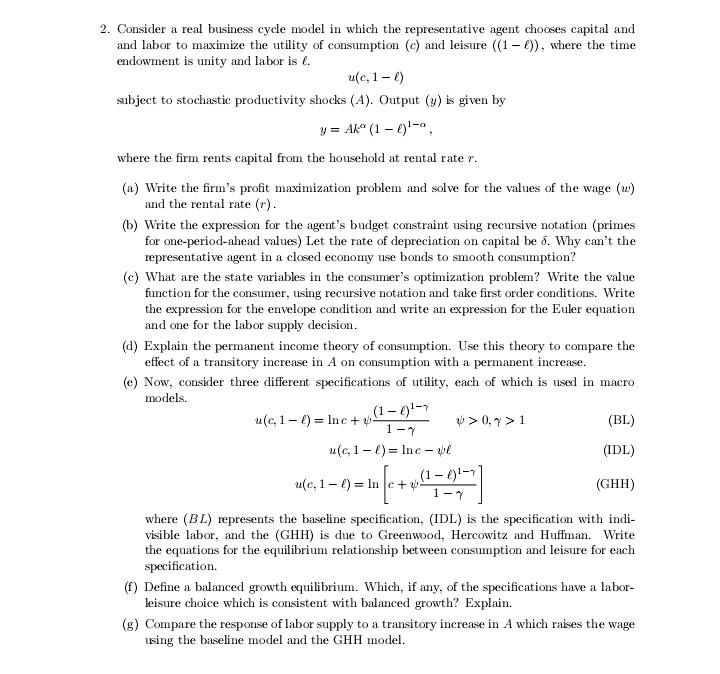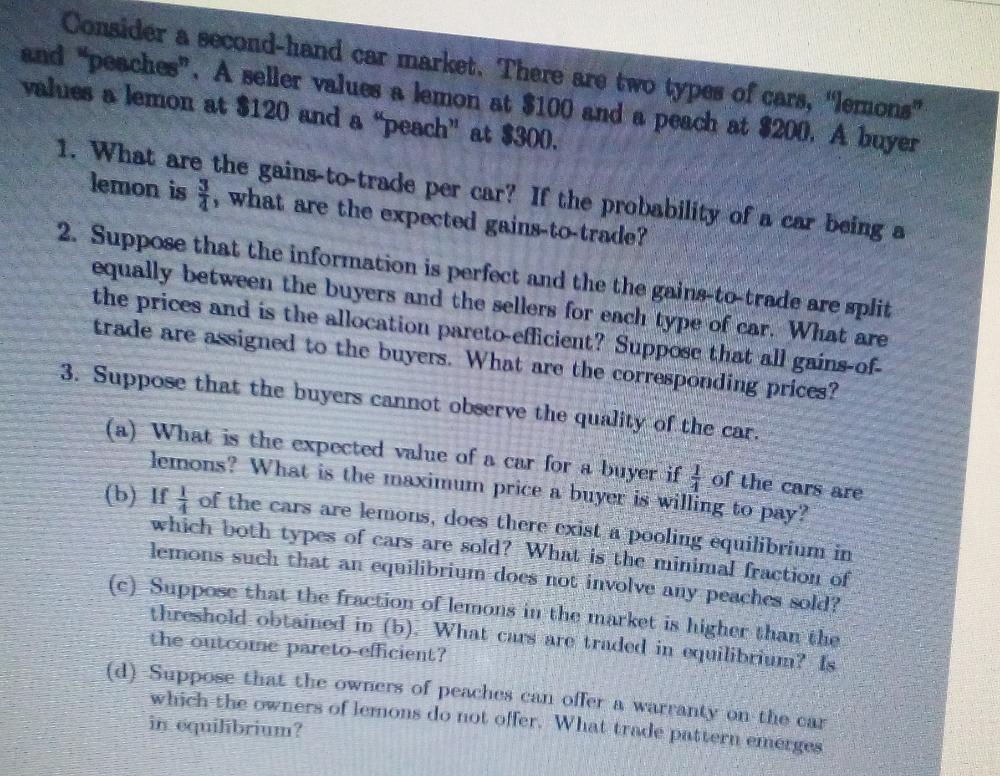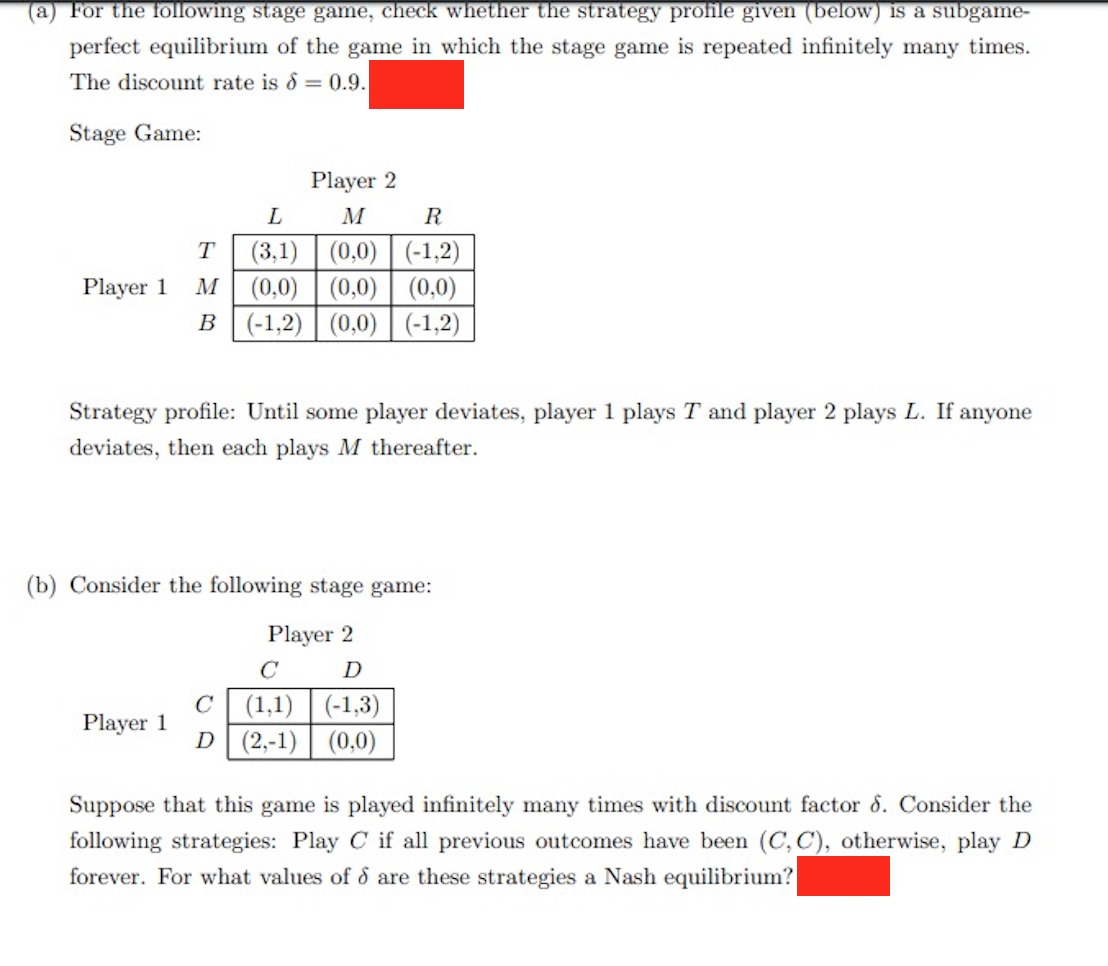Answered step by step
Verified Expert Solution
Question
1 Approved Answer
2. Consider a real business cycle model in which the representative agent chooses capital and and labor to maximize the utility of consumption (c)



2. Consider a real business cycle model in which the representative agent chooses capital and and labor to maximize the utility of consumption (c) and leisure ((1)), where the time endowment is unity and labor is . u(c, 1-l) subject to stochastic productivity shocks (A). Output (y) is given by y= Aka (1-0)-a where the firm rents capital from the household at rental rate r. (a) Write the firm's profit maximization problem and solve for the values of the wage (w) and the rental rate (r). (b) Write the expression for the agent's budget constraint using recursive notation (primes for one-period-ahead values) Let the rate of depreciation on capital be 5. Why can't the representative agent in a closed economy use bonds to smooth consumption? (c) What are the state variables in the consumer's optimization problem? Write the value function for the consumer, using recursive notation and take first order conditions. Write the expression for the envelope condition and write an expression for the Euler equation and one for the labor supply decision. (d) Explain the permanent income theory of consumption. Use this theory to compare the effect of a transitory increase in A on consumption with a permanent increase. (e) Now, consider three different specifications of utility, each of which is used in macro models. u(c,1 ) Inc+ 3 = (1-0)1-7 1-7 u(c. 1 ) Inc - vl 3 > 0,7 > 1 (BL) (IDL) u(c, 1 )Inc+3= (1-0)1-7 1-7 (GHH) where (BL) represents the baseline specification, (IDL) is the specification with indi- visible labor, and the (GHH) is due to Greenwood, Hercowitz and Huffman. Write the equations for the equilibrium relationship between consumption and leisure for each specification. (f) Define a balanced growth equilibrium. Which, if any, of the specifications have a labor- leisure choice which is consistent with balanced growth? Explain. (g) Compare the response of labor supply to a transitory increase in A which raises the wage using the baseline model and the GHH model. Consider a second-hand car market. There are two types of cars, "lemons" and "peaches". A seller values a lemon at $100 and a peach at $200. A buyer values a lemon at $120 and a "peach" at $300. 1. What are the gains-to-trade per car? If the probability of a car being a lemon is, what are the expected gains-to-trade? 2. Suppose that the information is perfect and the the gains-to-trade are split equally between the buyers and the sellers for each type of car. What are the prices and is the allocation pareto-efficient? Suppose that all gains-of- trade are assigned to the buyers. What are the corresponding prices? 3. Suppose that the buyers cannot observe the quality of the car. (a) What is the expected value of a car for a buyer if of the cars are lemons? What is the maximum price a buyer is willing to pay? (b) If of the cars are lemons, does there exist a pooling equilibrium in which both types of cars are sold? What is the minimal fraction of lemons such that an equilibrium does not involve any peaches sold? (c) Suppose that the fraction of lemons in the market is higher than the threshold obtained in (b). What cars are traded in equilibrium? Is the outcome pareto-efficient? (d) Suppose that the owners of peaches can offer a warranty on the car which the owners of lemons do not offer. What trade pattern emerges in equilibrium? (a) For the following stage game, check whether the strategy profile given (below) is a subgame- perfect equilibrium of the game in which the stage game is repeated infinitely many times. The discount rate is = 0.9. Stage Game: Player 2 L M R T (3.1) (0,0) (-1,2) Player 1 M (0,0) (0,0) (0,0) B (-1,2) (0,0) (-1,2) Strategy profile: Until some player deviates, player 1 plays T and player 2 plays L. If anyone deviates, then each plays M thereafter. (b) Consider the following stage game: Player 2 C D C (1,1) (-1,3) Player 1 D (2,-1) (0,0) Suppose that this game is played infinitely many times with discount factor 8. Consider the following strategies: Play C if all previous outcomes have been (C, C), otherwise, play D forever. For what values of 6 are these strategies a Nash equilibrium?
Step by Step Solution
There are 3 Steps involved in it
Step: 1

Get Instant Access to Expert-Tailored Solutions
See step-by-step solutions with expert insights and AI powered tools for academic success
Step: 2

Step: 3

Ace Your Homework with AI
Get the answers you need in no time with our AI-driven, step-by-step assistance
Get Started


